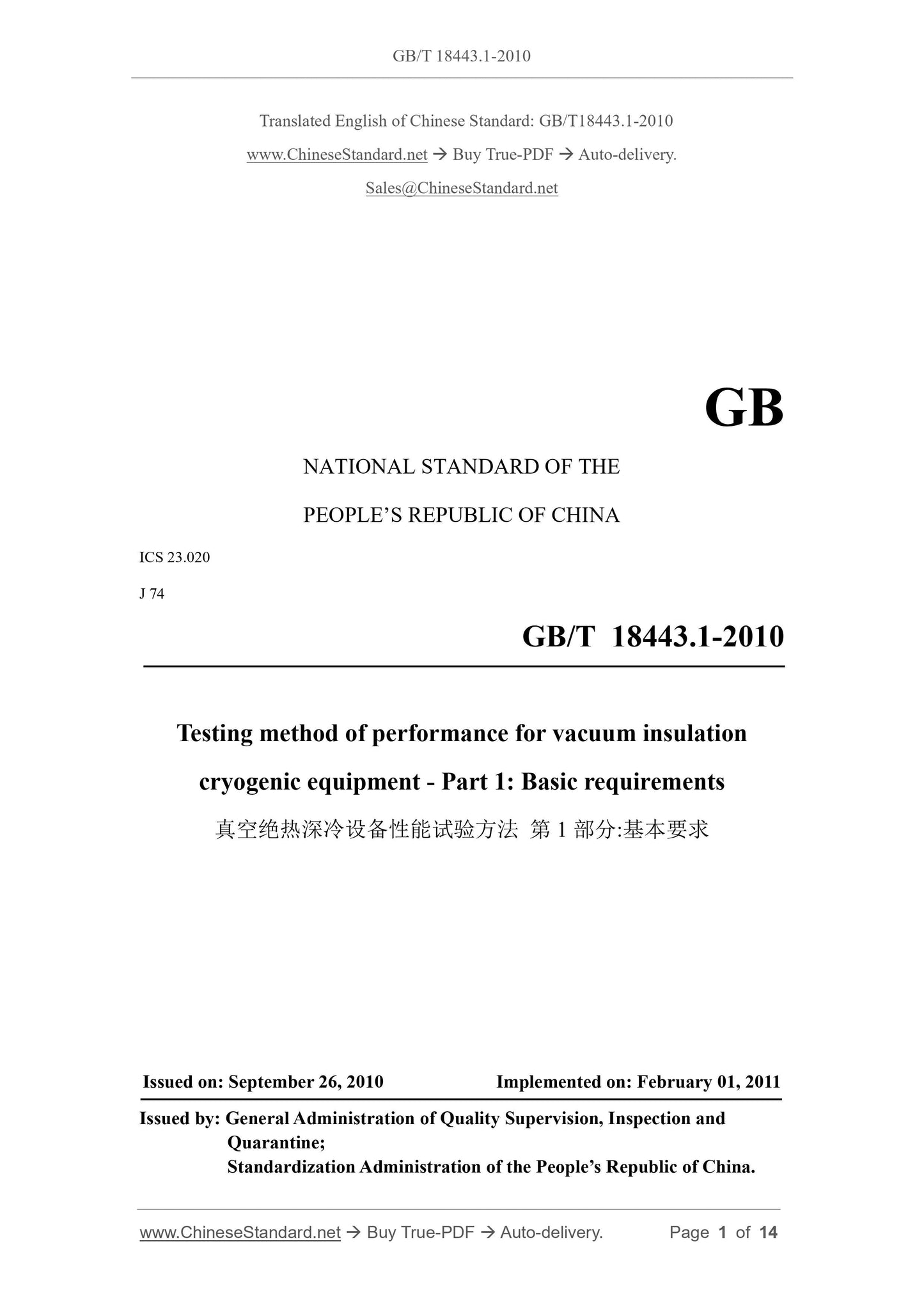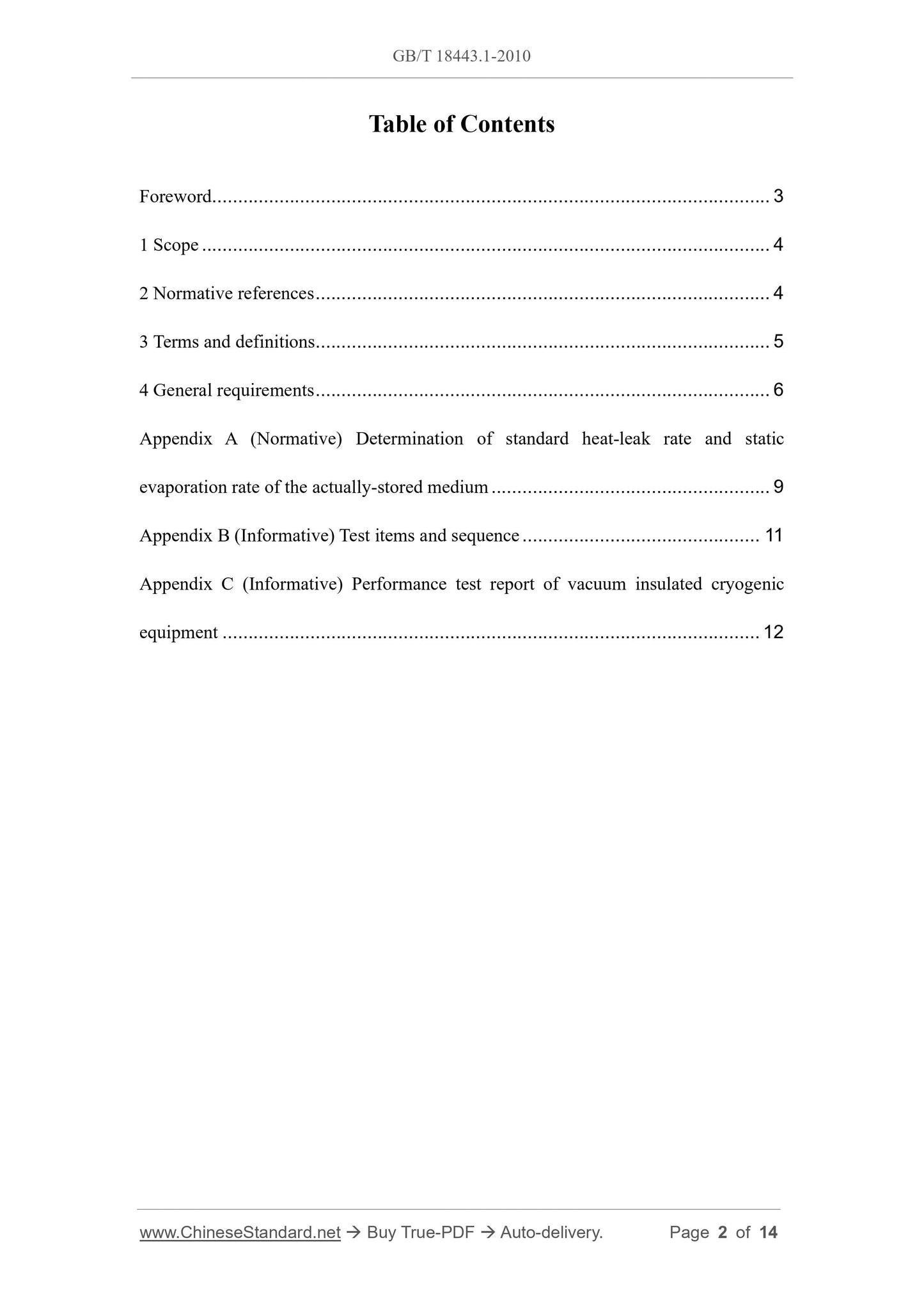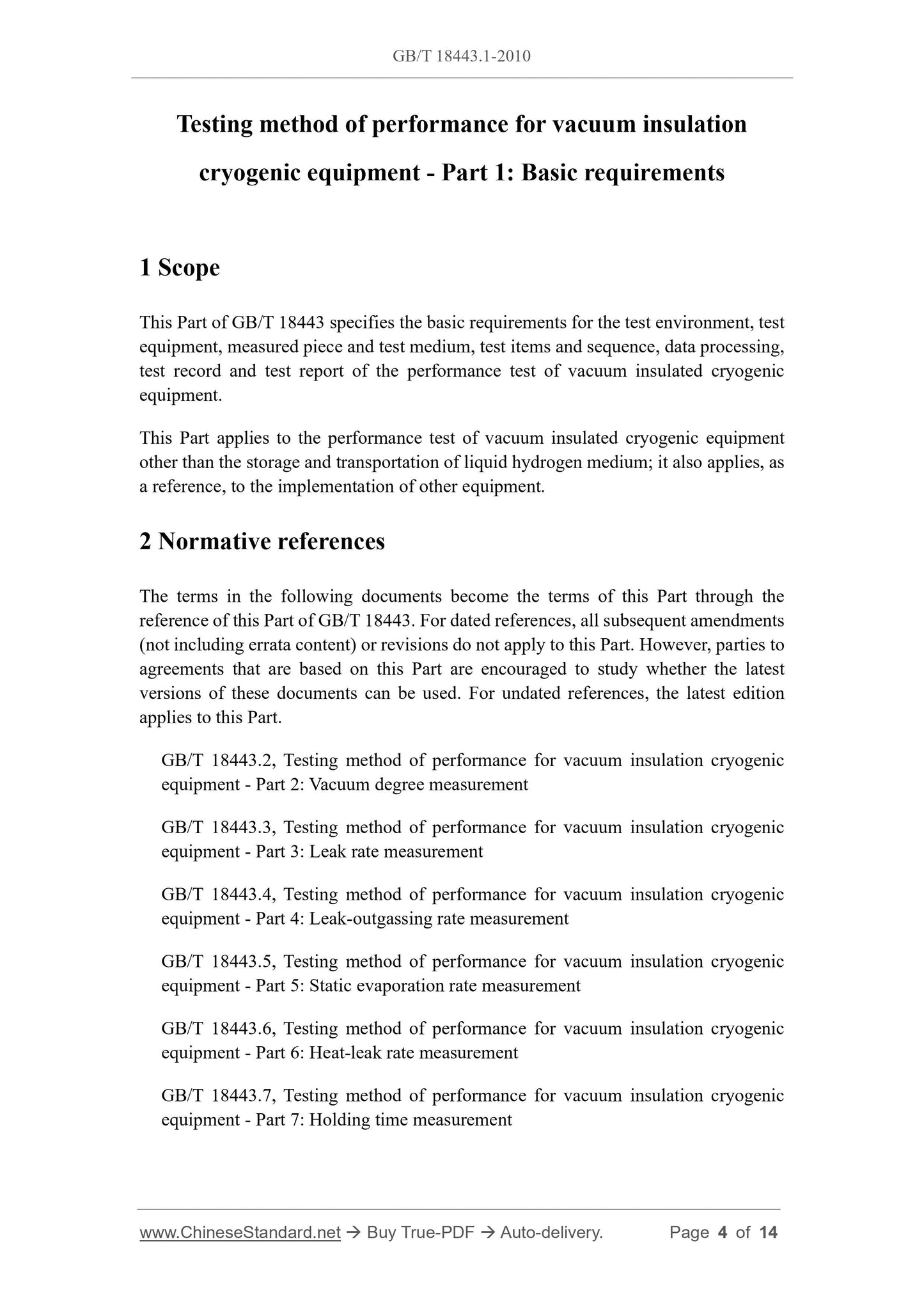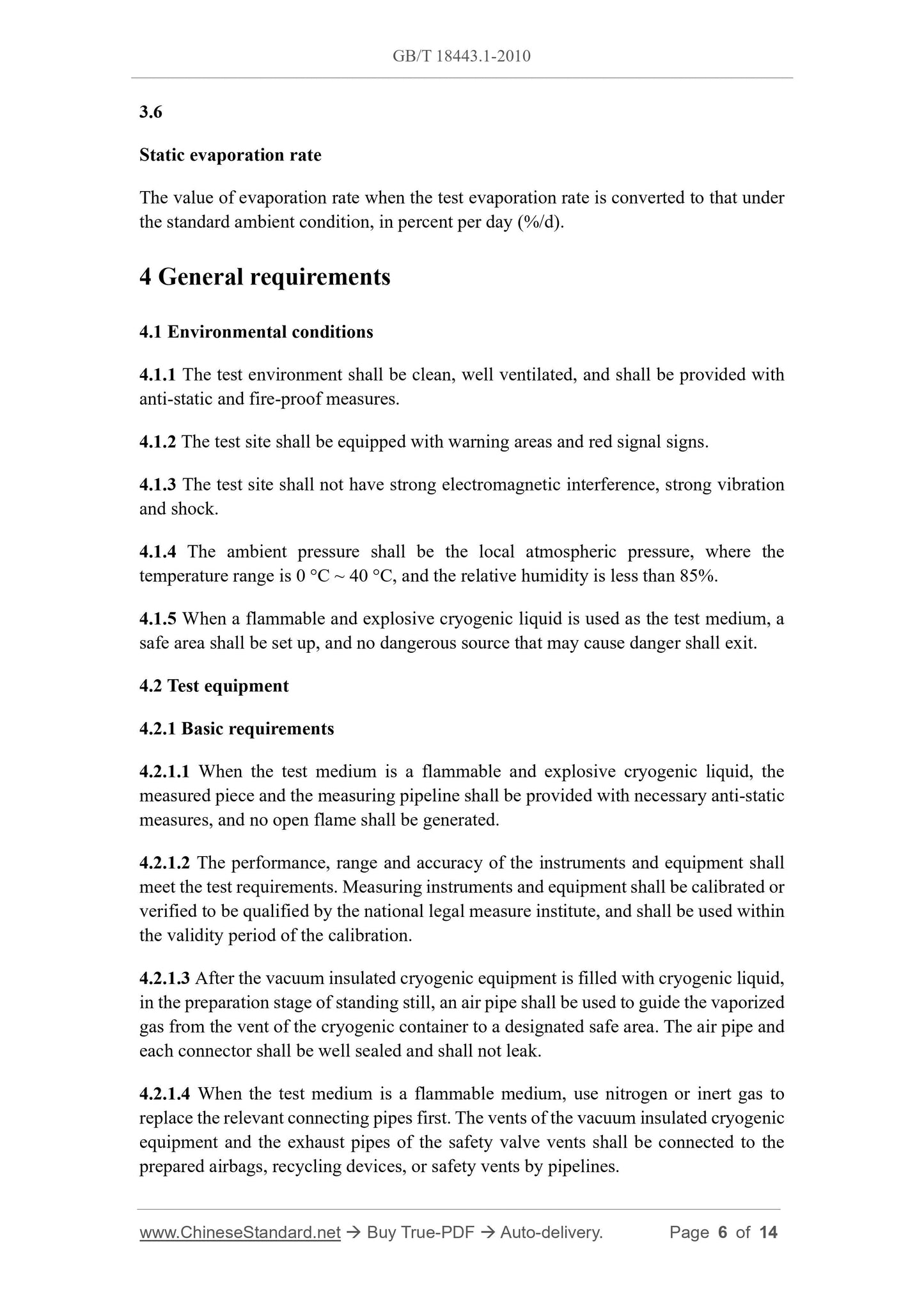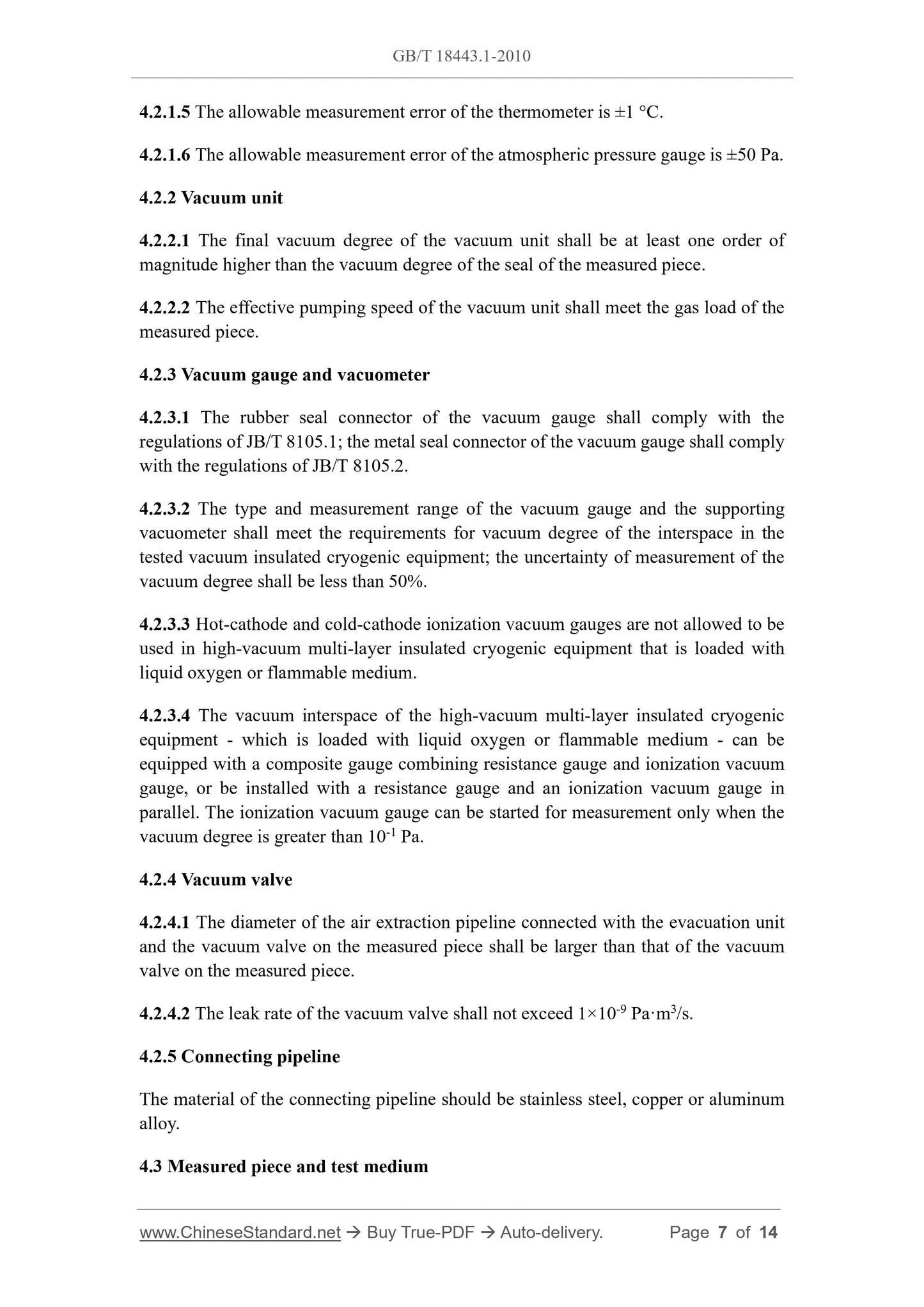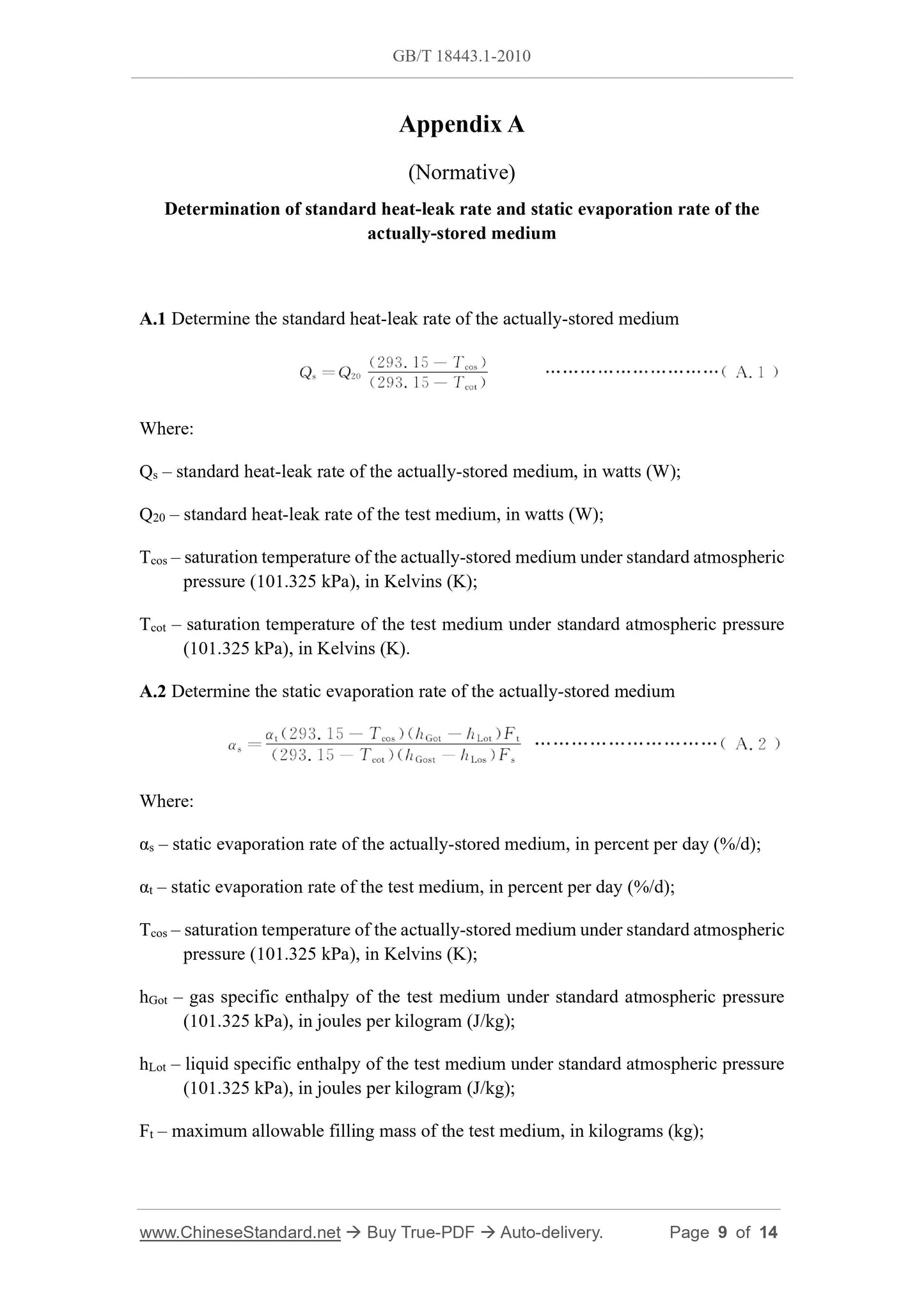1
/
of
6
www.ChineseStandard.us -- Field Test Asia Pte. Ltd.
GB/T 18443.1-2010 English PDF (GB/T18443.1-2010)
GB/T 18443.1-2010 English PDF (GB/T18443.1-2010)
Regular price
$70.00
Regular price
Sale price
$70.00
Unit price
/
per
Shipping calculated at checkout.
Couldn't load pickup availability
GB/T 18443.1-2010: Testing method of performance for vacuum insulation cryogenic equipment - Part 1: Basic requirements
Delivery: 9 seconds. Download (& Email) true-PDF + Invoice.
Get Quotation: Click GB/T 18443.1-2010 (Self-service in 1-minute)
Historical versions (Master-website): GB/T 18443.1-2010
Preview True-PDF (Reload/Scroll-down if blank)
GB/T 18443.1-2010
NATIONAL STANDARD OF THE
PEOPLE’S REPUBLIC OF CHINA
ICS 23.020
J 74
Testing method of performance for vacuum insulation
cryogenic equipment - Part 1.Basic requirements
ISSUED ON. SEPTEMBER 26, 2010
IMPLEMENTED ON. FEBRUARY 01, 2011
Issued by. General Administration of Quality Supervision, Inspection and
Quarantine;
Standardization Administration of the People’s Republic of China.
Table of Contents
Foreword... 3
1 Scope... 4
2 Normative references... 4
3 Terms and definitions... 5
4 General requirements... 6
Appendix A (Normative) Determination of standard heat-leak rate and static
evaporation rate of the actually-stored medium... 9
Appendix B (Informative) Test items and sequence... 11
Appendix C (Informative) Performance test report of vacuum insulated cryogenic
equipment... 12
Testing method of performance for vacuum insulation
cryogenic equipment - Part 1.Basic requirements
1 Scope
This Part of GB/T 18443 specifies the basic requirements for the test environment, test
equipment, measured piece and test medium, test items and sequence, data processing,
test record and test report of the performance test of vacuum insulated cryogenic
equipment.
This Part applies to the performance test of vacuum insulated cryogenic equipment
other than the storage and transportation of liquid hydrogen medium; it also applies, as
a reference, to the implementation of other equipment.
2 Normative references
The terms in the following documents become the terms of this Part through the
reference of this Part of GB/T 18443.For dated references, all subsequent amendments
(not including errata content) or revisions do not apply to this Part. However, parties to
agreements that are based on this Part are encouraged to study whether the latest
versions of these documents can be used. For undated references, the latest edition
applies to this Part.
GB/T 18443.2, Testing method of performance for vacuum insulation cryogenic
equipment - Part 2.Vacuum degree measurement
GB/T 18443.3, Testing method of performance for vacuum insulation cryogenic
equipment - Part 3.Leak rate measurement
GB/T 18443.4, Testing method of performance for vacuum insulation cryogenic
equipment - Part 4.Leak-outgassing rate measurement
GB/T 18443.5, Testing method of performance for vacuum insulation cryogenic
equipment - Part 5.Static evaporation rate measurement
GB/T 18443.6, Testing method of performance for vacuum insulation cryogenic
equipment - Part 6.Heat-leak rate measurement
GB/T 18443.7, Testing method of performance for vacuum insulation cryogenic
equipment - Part 7.Holding time measurement
3.6
Static evaporation rate
The value of evaporation rate when the test evaporation rate is converted to that under
the standard ambient condition, in percent per day (%/d).
4 General requirements
4.1 Environmental conditions
4.1.1 The test environment shall be clean, well ventilated, and shall be provided with
anti-static and fire-proof measures.
4.1.2 The test site shall be equipped with warning areas and red signal signs.
4.1.3 The test site shall not have strong electromagnetic interference, strong vibration
and shock.
4.1.4 The ambient pressure shall be the local atmospheric pressure, where the
temperature range is 0 °C ~ 40 °C, and the relative humidity is less than 85%.
4.1.5 When a flammable and explosive cryogenic liquid is used as the test medium, a
safe area shall be set up, and no dangerous source that may cause danger shall exit.
4.2 Test equipment
4.2.1 Basic requirements
4.2.1.1 When the test medium is a flammable and explosive cryogenic liquid, the
measured piece and the measuring pipeline shall be provided with necessary anti-static
measures, and no open flame shall be generated.
4.2.1.2 The performance, range and accuracy of the instruments and equipment shall
meet the test requirements. Measuring instruments and equipment shall be calibrated or
verified to be qualified by the national legal measure institute, and shall be used within
the validity period of the calibration.
4.2.1.3 After the vacuum insulated cryogenic equipment is filled with cryogenic liquid,
in the preparation stage of standing still, an air pipe shall be used to guide the vaporized
gas from the vent of the cryogenic container to a designated safe area. The air pipe and
each connector shall be well sealed and shall not leak.
4.2.1.4 When the test medium is a flammable medium, use nitrogen or inert gas to
replace the relevant connecting pipes first. The vents of the vacuum insulated cryogenic
equipment and the exhaust pipes of the safety valve vents shall be connected to the
prepared airbags, recycling devices, or safety vents by pipelines.
4.2.1.5 The allowable measurement error of the thermometer is ±1 °C.
4.2.1.6 The allowable measurement error of the atmospheric pressure gauge is ±50 Pa.
4.2.2 Vacuum unit
4.2.2.1 The final vacuum degree of the vacuum unit shall be at least one order of
magnitude higher than the vacuum degree of the seal of the measured piece.
4.2.2.2 The effective pumping speed of the vacuum unit shall meet the gas load of the
measured piece.
4.2.3 Vacuum gauge and vacuometer
4.2.3.1 The rubber seal connector of the vacuum gauge shall comply with the
regulations of JB/T 8105.1; the metal seal connector of the vacuum gauge shall comply
with the regulations of JB/T 8105.2.
4.2.3.2 The type and measurement range of the vacuum gauge and the supporting
vacuometer shall meet the requirements for vacuum degree of the interspace in the
tested vacuum insulated cryogenic equipment; the uncertainty of measurement of the
vacuum degree shall be less than 50%.
4.2.3.3 Hot-cathode and cold-cathode ionization vacuum gauges are not allowed to be
used in high-vacuum multi-layer insulated cryogenic equipment that is loaded with
liquid oxygen or flammable medium.
4.2.3.4 The vacuum interspace of the high-vacuum multi-layer insulated cryogenic
equipment - which is loaded with liquid oxygen or flammable medium - can be
equipped with a composite gauge combining resistance gauge and ionization vacuum
gauge, or be installed with a resistance gauge and an ionization vacuum gauge in
parallel. The ionization vacuum gauge can be started for measurement only when the
vacuum degree is greater than 10-1 Pa.
4.2.4 Vacuum valve
4.2.4.1 The diameter of the air extraction pipeline connected with the evacuation unit
and the vacuum valve on the measured piece shall be larger than that of the vacuum
valve on the measured piece.
4.2.4.2 The leak rate of the vacuum valve shall not exceed 1×10-9 Pa·m3/s.
4.2.5 Connecting pipeline
The material of the connecting pipeline should be stainless steel, copper or aluminum
alloy.
4.3 Measured piece and test medium
Appendix A
(Normative)
Determination of standard heat-leak rate and static evaporation rate of the
actually-stored medium
A.1 Determine the standard heat-leak rate of the actually-stored medium
Where.
Qs – standard heat-leak rate of the actually-stored medium, in watts (W);
Q20 – standard heat-leak rate of the test medium, in watts (W);
Tcos – saturation temperature of the actually-stored medium under standard atmospheric
pressure (101.325 kPa), in Kelvins (K);
Tcot – saturation temperature of the test medium under standard atmospheric pressure
(101.325 kPa), in Kelvins (K).
A.2 Determine the static evaporation rate of the actually-stored medium
Where.
αs – static evaporation rate of the actually-stored medium, in percent per day (%/d);
αt – static evaporation rate of the test medium, in percent per day (%/d);
Tcos – saturation temperature of the actually-stored medium under standard atmospheric
pressure (101.325 kPa), in Kelvins (K);
hGot – gas specific enthalpy of the test medium under standard atmospheric pressure
(101.325 kPa), in joules per kilogram (J/kg);
hLot – liquid specific enthalpy of the test medium under standard atmospheric pressure
(101.325 kPa), in joules per kilogram (J/kg);
Ft – maximum allowable filling mass of the test medium, in kilograms (kg);
GB/T 18443.1-2010
NATIONAL STANDARD OF THE
PEOPLE’S REPUBLIC OF CHINA
ICS 23.020
J 74
Testing method of performance for vacuum insulation
cryogenic equipment - Part 1.Basic requirements
ISSUED ON. SEPTEMBER 26, 2010
IMPLEMENTED ON. FEBRUARY 01, 2011
Issued by. General Administration of Quality Supervision, Inspection and
Quarantine;
Standardization Administration of the People’s Republic of China.
Table of Contents
Foreword... 3
1 Scope... 4
2 Normative references... 4
3 Terms and definitions... 5
4 General requirements... 6
Appendix A (Normative) Determination of standard heat-leak rate and static
evaporation rate of the actually-stored medium... 9
Appendix B (Informative) Test items and sequence... 11
Appendix C (Informative) Performance test report of vacuum insulated cryogenic
equipment... 12
Testing method of performance for vacuum insulation
cryogenic equipment - Part 1.Basic requirements
1 Scope
This Part of GB/T 18443 specifies the basic requirements for the test environment, test
equipment, measured piece and test medium, test items and sequence, data processing,
test record and test report of the performance test of vacuum insulated cryogenic
equipment.
This Part applies to the performance test of vacuum insulated cryogenic equipment
other than the storage and transportation of liquid hydrogen medium; it also applies, as
a reference, to the implementation of other equipment.
2 Normative references
The terms in the following documents become the terms of this Part through the
reference of this Part of GB/T 18443.For dated references, all subsequent amendments
(not including errata content) or revisions do not apply to this Part. However, parties to
agreements that are based on this Part are encouraged to study whether the latest
versions of these documents can be used. For undated references, the latest edition
applies to this Part.
GB/T 18443.2, Testing method of performance for vacuum insulation cryogenic
equipment - Part 2.Vacuum degree measurement
GB/T 18443.3, Testing method of performance for vacuum insulation cryogenic
equipment - Part 3.Leak rate measurement
GB/T 18443.4, Testing method of performance for vacuum insulation cryogenic
equipment - Part 4.Leak-outgassing rate measurement
GB/T 18443.5, Testing method of performance for vacuum insulation cryogenic
equipment - Part 5.Static evaporation rate measurement
GB/T 18443.6, Testing method of performance for vacuum insulation cryogenic
equipment - Part 6.Heat-leak rate measurement
GB/T 18443.7, Testing method of performance for vacuum insulation cryogenic
equipment - Part 7.Holding time measurement
3.6
Static evaporation rate
The value of evaporation rate when the test evaporation rate is converted to that under
the standard ambient condition, in percent per day (%/d).
4 General requirements
4.1 Environmental conditions
4.1.1 The test environment shall be clean, well ventilated, and shall be provided with
anti-static and fire-proof measures.
4.1.2 The test site shall be equipped with warning areas and red signal signs.
4.1.3 The test site shall not have strong electromagnetic interference, strong vibration
and shock.
4.1.4 The ambient pressure shall be the local atmospheric pressure, where the
temperature range is 0 °C ~ 40 °C, and the relative humidity is less than 85%.
4.1.5 When a flammable and explosive cryogenic liquid is used as the test medium, a
safe area shall be set up, and no dangerous source that may cause danger shall exit.
4.2 Test equipment
4.2.1 Basic requirements
4.2.1.1 When the test medium is a flammable and explosive cryogenic liquid, the
measured piece and the measuring pipeline shall be provided with necessary anti-static
measures, and no open flame shall be generated.
4.2.1.2 The performance, range and accuracy of the instruments and equipment shall
meet the test requirements. Measuring instruments and equipment shall be calibrated or
verified to be qualified by the national legal measure institute, and shall be used within
the validity period of the calibration.
4.2.1.3 After the vacuum insulated cryogenic equipment is filled with cryogenic liquid,
in the preparation stage of standing still, an air pipe shall be used to guide the vaporized
gas from the vent of the cryogenic container to a designated safe area. The air pipe and
each connector shall be well sealed and shall not leak.
4.2.1.4 When the test medium is a flammable medium, use nitrogen or inert gas to
replace the relevant connecting pipes first. The vents of the vacuum insulated cryogenic
equipment and the exhaust pipes of the safety valve vents shall be connected to the
prepared airbags, recycling devices, or safety vents by pipelines.
4.2.1.5 The allowable measurement error of the thermometer is ±1 °C.
4.2.1.6 The allowable measurement error of the atmospheric pressure gauge is ±50 Pa.
4.2.2 Vacuum unit
4.2.2.1 The final vacuum degree of the vacuum unit shall be at least one order of
magnitude higher than the vacuum degree of the seal of the measured piece.
4.2.2.2 The effective pumping speed of the vacuum unit shall meet the gas load of the
measured piece.
4.2.3 Vacuum gauge and vacuometer
4.2.3.1 The rubber seal connector of the vacuum gauge shall comply with the
regulations of JB/T 8105.1; the metal seal connector of the vacuum gauge shall comply
with the regulations of JB/T 8105.2.
4.2.3.2 The type and measurement range of the vacuum gauge and the supporting
vacuometer shall meet the requirements for vacuum degree of the interspace in the
tested vacuum insulated cryogenic equipment; the uncertainty of measurement of the
vacuum degree shall be less than 50%.
4.2.3.3 Hot-cathode and cold-cathode ionization vacuum gauges are not allowed to be
used in high-vacuum multi-layer insulated cryogenic equipment that is loaded with
Delivery: 9 seconds. Download (& Email) true-PDF + Invoice.
Get Quotation: Click GB/T 18443.1-2010 (Self-service in 1-minute)
Historical versions (Master-website): GB/T 18443.1-2010
Preview True-PDF (Reload/Scroll-down if blank)
GB/T 18443.1-2010
NATIONAL STANDARD OF THE
PEOPLE’S REPUBLIC OF CHINA
ICS 23.020
J 74
Testing method of performance for vacuum insulation
cryogenic equipment - Part 1.Basic requirements
ISSUED ON. SEPTEMBER 26, 2010
IMPLEMENTED ON. FEBRUARY 01, 2011
Issued by. General Administration of Quality Supervision, Inspection and
Quarantine;
Standardization Administration of the People’s Republic of China.
Table of Contents
Foreword... 3
1 Scope... 4
2 Normative references... 4
3 Terms and definitions... 5
4 General requirements... 6
Appendix A (Normative) Determination of standard heat-leak rate and static
evaporation rate of the actually-stored medium... 9
Appendix B (Informative) Test items and sequence... 11
Appendix C (Informative) Performance test report of vacuum insulated cryogenic
equipment... 12
Testing method of performance for vacuum insulation
cryogenic equipment - Part 1.Basic requirements
1 Scope
This Part of GB/T 18443 specifies the basic requirements for the test environment, test
equipment, measured piece and test medium, test items and sequence, data processing,
test record and test report of the performance test of vacuum insulated cryogenic
equipment.
This Part applies to the performance test of vacuum insulated cryogenic equipment
other than the storage and transportation of liquid hydrogen medium; it also applies, as
a reference, to the implementation of other equipment.
2 Normative references
The terms in the following documents become the terms of this Part through the
reference of this Part of GB/T 18443.For dated references, all subsequent amendments
(not including errata content) or revisions do not apply to this Part. However, parties to
agreements that are based on this Part are encouraged to study whether the latest
versions of these documents can be used. For undated references, the latest edition
applies to this Part.
GB/T 18443.2, Testing method of performance for vacuum insulation cryogenic
equipment - Part 2.Vacuum degree measurement
GB/T 18443.3, Testing method of performance for vacuum insulation cryogenic
equipment - Part 3.Leak rate measurement
GB/T 18443.4, Testing method of performance for vacuum insulation cryogenic
equipment - Part 4.Leak-outgassing rate measurement
GB/T 18443.5, Testing method of performance for vacuum insulation cryogenic
equipment - Part 5.Static evaporation rate measurement
GB/T 18443.6, Testing method of performance for vacuum insulation cryogenic
equipment - Part 6.Heat-leak rate measurement
GB/T 18443.7, Testing method of performance for vacuum insulation cryogenic
equipment - Part 7.Holding time measurement
3.6
Static evaporation rate
The value of evaporation rate when the test evaporation rate is converted to that under
the standard ambient condition, in percent per day (%/d).
4 General requirements
4.1 Environmental conditions
4.1.1 The test environment shall be clean, well ventilated, and shall be provided with
anti-static and fire-proof measures.
4.1.2 The test site shall be equipped with warning areas and red signal signs.
4.1.3 The test site shall not have strong electromagnetic interference, strong vibration
and shock.
4.1.4 The ambient pressure shall be the local atmospheric pressure, where the
temperature range is 0 °C ~ 40 °C, and the relative humidity is less than 85%.
4.1.5 When a flammable and explosive cryogenic liquid is used as the test medium, a
safe area shall be set up, and no dangerous source that may cause danger shall exit.
4.2 Test equipment
4.2.1 Basic requirements
4.2.1.1 When the test medium is a flammable and explosive cryogenic liquid, the
measured piece and the measuring pipeline shall be provided with necessary anti-static
measures, and no open flame shall be generated.
4.2.1.2 The performance, range and accuracy of the instruments and equipment shall
meet the test requirements. Measuring instruments and equipment shall be calibrated or
verified to be qualified by the national legal measure institute, and shall be used within
the validity period of the calibration.
4.2.1.3 After the vacuum insulated cryogenic equipment is filled with cryogenic liquid,
in the preparation stage of standing still, an air pipe shall be used to guide the vaporized
gas from the vent of the cryogenic container to a designated safe area. The air pipe and
each connector shall be well sealed and shall not leak.
4.2.1.4 When the test medium is a flammable medium, use nitrogen or inert gas to
replace the relevant connecting pipes first. The vents of the vacuum insulated cryogenic
equipment and the exhaust pipes of the safety valve vents shall be connected to the
prepared airbags, recycling devices, or safety vents by pipelines.
4.2.1.5 The allowable measurement error of the thermometer is ±1 °C.
4.2.1.6 The allowable measurement error of the atmospheric pressure gauge is ±50 Pa.
4.2.2 Vacuum unit
4.2.2.1 The final vacuum degree of the vacuum unit shall be at least one order of
magnitude higher than the vacuum degree of the seal of the measured piece.
4.2.2.2 The effective pumping speed of the vacuum unit shall meet the gas load of the
measured piece.
4.2.3 Vacuum gauge and vacuometer
4.2.3.1 The rubber seal connector of the vacuum gauge shall comply with the
regulations of JB/T 8105.1; the metal seal connector of the vacuum gauge shall comply
with the regulations of JB/T 8105.2.
4.2.3.2 The type and measurement range of the vacuum gauge and the supporting
vacuometer shall meet the requirements for vacuum degree of the interspace in the
tested vacuum insulated cryogenic equipment; the uncertainty of measurement of the
vacuum degree shall be less than 50%.
4.2.3.3 Hot-cathode and cold-cathode ionization vacuum gauges are not allowed to be
used in high-vacuum multi-layer insulated cryogenic equipment that is loaded with
liquid oxygen or flammable medium.
4.2.3.4 The vacuum interspace of the high-vacuum multi-layer insulated cryogenic
equipment - which is loaded with liquid oxygen or flammable medium - can be
equipped with a composite gauge combining resistance gauge and ionization vacuum
gauge, or be installed with a resistance gauge and an ionization vacuum gauge in
parallel. The ionization vacuum gauge can be started for measurement only when the
vacuum degree is greater than 10-1 Pa.
4.2.4 Vacuum valve
4.2.4.1 The diameter of the air extraction pipeline connected with the evacuation unit
and the vacuum valve on the measured piece shall be larger than that of the vacuum
valve on the measured piece.
4.2.4.2 The leak rate of the vacuum valve shall not exceed 1×10-9 Pa·m3/s.
4.2.5 Connecting pipeline
The material of the connecting pipeline should be stainless steel, copper or aluminum
alloy.
4.3 Measured piece and test medium
Appendix A
(Normative)
Determination of standard heat-leak rate and static evaporation rate of the
actually-stored medium
A.1 Determine the standard heat-leak rate of the actually-stored medium
Where.
Qs – standard heat-leak rate of the actually-stored medium, in watts (W);
Q20 – standard heat-leak rate of the test medium, in watts (W);
Tcos – saturation temperature of the actually-stored medium under standard atmospheric
pressure (101.325 kPa), in Kelvins (K);
Tcot – saturation temperature of the test medium under standard atmospheric pressure
(101.325 kPa), in Kelvins (K).
A.2 Determine the static evaporation rate of the actually-stored medium
Where.
αs – static evaporation rate of the actually-stored medium, in percent per day (%/d);
αt – static evaporation rate of the test medium, in percent per day (%/d);
Tcos – saturation temperature of the actually-stored medium under standard atmospheric
pressure (101.325 kPa), in Kelvins (K);
hGot – gas specific enthalpy of the test medium under standard atmospheric pressure
(101.325 kPa), in joules per kilogram (J/kg);
hLot – liquid specific enthalpy of the test medium under standard atmospheric pressure
(101.325 kPa), in joules per kilogram (J/kg);
Ft – maximum allowable filling mass of the test medium, in kilograms (kg);
GB/T 18443.1-2010
NATIONAL STANDARD OF THE
PEOPLE’S REPUBLIC OF CHINA
ICS 23.020
J 74
Testing method of performance for vacuum insulation
cryogenic equipment - Part 1.Basic requirements
ISSUED ON. SEPTEMBER 26, 2010
IMPLEMENTED ON. FEBRUARY 01, 2011
Issued by. General Administration of Quality Supervision, Inspection and
Quarantine;
Standardization Administration of the People’s Republic of China.
Table of Contents
Foreword... 3
1 Scope... 4
2 Normative references... 4
3 Terms and definitions... 5
4 General requirements... 6
Appendix A (Normative) Determination of standard heat-leak rate and static
evaporation rate of the actually-stored medium... 9
Appendix B (Informative) Test items and sequence... 11
Appendix C (Informative) Performance test report of vacuum insulated cryogenic
equipment... 12
Testing method of performance for vacuum insulation
cryogenic equipment - Part 1.Basic requirements
1 Scope
This Part of GB/T 18443 specifies the basic requirements for the test environment, test
equipment, measured piece and test medium, test items and sequence, data processing,
test record and test report of the performance test of vacuum insulated cryogenic
equipment.
This Part applies to the performance test of vacuum insulated cryogenic equipment
other than the storage and transportation of liquid hydrogen medium; it also applies, as
a reference, to the implementation of other equipment.
2 Normative references
The terms in the following documents become the terms of this Part through the
reference of this Part of GB/T 18443.For dated references, all subsequent amendments
(not including errata content) or revisions do not apply to this Part. However, parties to
agreements that are based on this Part are encouraged to study whether the latest
versions of these documents can be used. For undated references, the latest edition
applies to this Part.
GB/T 18443.2, Testing method of performance for vacuum insulation cryogenic
equipment - Part 2.Vacuum degree measurement
GB/T 18443.3, Testing method of performance for vacuum insulation cryogenic
equipment - Part 3.Leak rate measurement
GB/T 18443.4, Testing method of performance for vacuum insulation cryogenic
equipment - Part 4.Leak-outgassing rate measurement
GB/T 18443.5, Testing method of performance for vacuum insulation cryogenic
equipment - Part 5.Static evaporation rate measurement
GB/T 18443.6, Testing method of performance for vacuum insulation cryogenic
equipment - Part 6.Heat-leak rate measurement
GB/T 18443.7, Testing method of performance for vacuum insulation cryogenic
equipment - Part 7.Holding time measurement
3.6
Static evaporation rate
The value of evaporation rate when the test evaporation rate is converted to that under
the standard ambient condition, in percent per day (%/d).
4 General requirements
4.1 Environmental conditions
4.1.1 The test environment shall be clean, well ventilated, and shall be provided with
anti-static and fire-proof measures.
4.1.2 The test site shall be equipped with warning areas and red signal signs.
4.1.3 The test site shall not have strong electromagnetic interference, strong vibration
and shock.
4.1.4 The ambient pressure shall be the local atmospheric pressure, where the
temperature range is 0 °C ~ 40 °C, and the relative humidity is less than 85%.
4.1.5 When a flammable and explosive cryogenic liquid is used as the test medium, a
safe area shall be set up, and no dangerous source that may cause danger shall exit.
4.2 Test equipment
4.2.1 Basic requirements
4.2.1.1 When the test medium is a flammable and explosive cryogenic liquid, the
measured piece and the measuring pipeline shall be provided with necessary anti-static
measures, and no open flame shall be generated.
4.2.1.2 The performance, range and accuracy of the instruments and equipment shall
meet the test requirements. Measuring instruments and equipment shall be calibrated or
verified to be qualified by the national legal measure institute, and shall be used within
the validity period of the calibration.
4.2.1.3 After the vacuum insulated cryogenic equipment is filled with cryogenic liquid,
in the preparation stage of standing still, an air pipe shall be used to guide the vaporized
gas from the vent of the cryogenic container to a designated safe area. The air pipe and
each connector shall be well sealed and shall not leak.
4.2.1.4 When the test medium is a flammable medium, use nitrogen or inert gas to
replace the relevant connecting pipes first. The vents of the vacuum insulated cryogenic
equipment and the exhaust pipes of the safety valve vents shall be connected to the
prepared airbags, recycling devices, or safety vents by pipelines.
4.2.1.5 The allowable measurement error of the thermometer is ±1 °C.
4.2.1.6 The allowable measurement error of the atmospheric pressure gauge is ±50 Pa.
4.2.2 Vacuum unit
4.2.2.1 The final vacuum degree of the vacuum unit shall be at least one order of
magnitude higher than the vacuum degree of the seal of the measured piece.
4.2.2.2 The effective pumping speed of the vacuum unit shall meet the gas load of the
measured piece.
4.2.3 Vacuum gauge and vacuometer
4.2.3.1 The rubber seal connector of the vacuum gauge shall comply with the
regulations of JB/T 8105.1; the metal seal connector of the vacuum gauge shall comply
with the regulations of JB/T 8105.2.
4.2.3.2 The type and measurement range of the vacuum gauge and the supporting
vacuometer shall meet the requirements for vacuum degree of the interspace in the
tested vacuum insulated cryogenic equipment; the uncertainty of measurement of the
vacuum degree shall be less than 50%.
4.2.3.3 Hot-cathode and cold-cathode ionization vacuum gauges are not allowed to be
used in high-vacuum multi-layer insulated cryogenic equipment that is loaded with
Share
